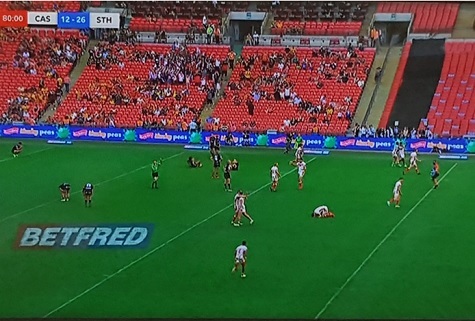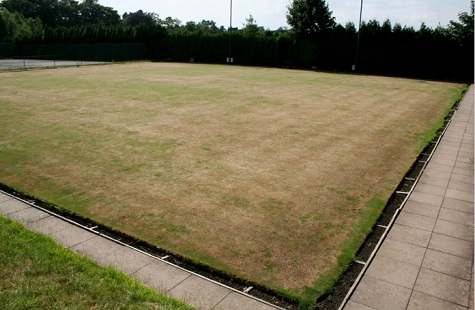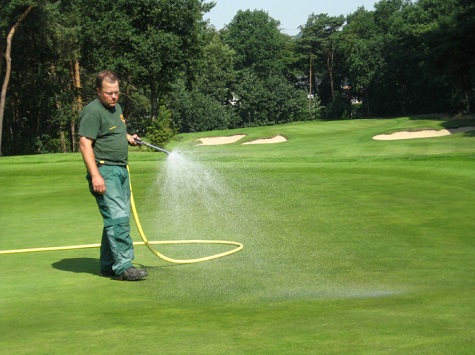Another great weekend of sport with the Rugby League cup final being played at a sweltering Wembley Stadium. Credit to all the players competing in such hot conditions with St Helens coming out winners 26 / 12.
We also saw the conclusion of the British Open played Sunday at Royal St George’s Golf Course in Kent, won by Collin Morikawa. Finally we witnessed Lewis Hamilton winning his 8th British Grand Prix at Silverstone.

A thought should be spared for all those turf professionals who had to prepare and repair these facilities during this mini heat wave.
This year’s spell of sunny hot weather has certainly arrived where I’m based in Shropshire - with the same seemingly applicable for most parts of the country. With air temperatures rising into the high 20s, there is no doubt that our playing surfaces are going to be under stress in more ways than one -especially if you do not have appropriate watering facilities on hand.
Irrigation
Most professional club facilities will have invested in a decent watering system, whether it is in the form of automated pop-up irrigation sprinklers or manually controlled watering devices such as boom spray irrigators, self-traveling and static sprinklers.

Those club facilities that do not have adequate watering facilities, they will have to rely on the weather and hope that some rain is forecast in the coming weeks. Hovever, the grass plant is quite resilient and can soon recover reasonably well after a dose of rain.
The problem becomes more acute if these hot periods drag on. We then begin to see the signs of heat stress and soils becoming hydrophobic. Once this happens, it generally takes longer for the turf to recover, often needing some intervention to overcome these issues.
Generally, the problem is more acute on sandy soils. Hydrophobic soil occurs when a waxy residue builds up on the soil particles resulting in it repelling water rather than absorbing it. It is most common in sandy soils, dried out potting mix and soils containing unrotted organic matter. You can identify hydrophobic soil by watering it. If water runs off or pools on the surface leaving the soil underneath dry, you've got Hydrophobic soil.

The application of wetting agents is a great quick fix but will not resolve the issue long term. Wetting agents work by breaking down waxy coatings as well as breaking the surface tension in the water making it easier to penetrate the soil. A better, long-term way to improve your soil is by adding well-rotted organic matter, then mulching over the top to help prevent the soil from drying out. This will introduce microorganisms to your soil which will break down the waxy residue and improving your soil biology.
However, this is generally more difficult to achieve on fine turf surfaces especially those predominantly constructed using sand based rootzones. Effectively it is then all about a preventive strategy of encouraging vigorous healthy growth by feeding with an array of organic feeds, applying wetting agents, employing a good aeration programme and above all having an effective watering system in place.
However, having said that, there are times when some clubs who do have a decent watering system, tend to go the other way and are applying and wasting too much water. This comes at a cost both in terms of finances (cost of water) as well as causing more turf related problems such as a build-up of thatch, weeds and diseases.

I know of one bowling club a few years ago who religiously put their pop-up watering system on every other night, come rain or shine and wondered why the green was so lush and spongy?
Nowadays, irrigation is an important and integral part of the turf grass management industry, especially as the demand for better quality playing surfaces has increased. This demand has been largely due to extensive televised coverage of major sporting events. Seeing immaculate aesthetically presented golf courses, football, rugby pitches and horse racing courses has increased the expectations of the players and viewers.
Most professional sporting facilities have irrigation systems of one sort or another. Without them they would not be able to prepare and maintain their playing surfaces.
Water balance
All grass plants are a continuum of water movement. Over 90% of the plant's water requirements are transported through the plant from the soil profile, via the roots and stem tissues into the leaves and out into the atmosphere. Knowledge of these relationships is important when designing and operating irrigation systems. The main aim is to achieve a water balance within the soil profile ensuring that the grass plant can access available water from the soil.
The soil water balance will be affected by several factors:
- Soil type and condition; the water holding capacity of soils will vary depending on their classification. Clay soils can hold more water than loamy or sandy soils, therefore soil type will affect and contribute to the amount of water required. Soils are continually going through phases of wetting and drying caused by local weather conditions.
- Weather; air temperature, daylight hours, solar energy inputs, wind speed and shading are factors that will affect evapotranspiration rates.
- Maintenance regimes: keeping the soil open and aerated will increase the drainage capacity of the soil. On the other hand, compacted soils will prevent the movement of water through soils, often creating an environment that prevents water getting down into the soil profile. By carrying out effective regular maintenance regimes that include aeration, scarifying, harrowing, brushing, top dressing all help to keep the soil in good condition.
- Irrigation system; type, capacity, running time, calibration and efficiency.
- Water resources; quantity and quality. The quantity of water available, and the amount licensed for use in any one year, will determine the performance of any system and irrigation capabilities.
- Facility type; design and construction. USGA greens perform differently to pushed up soil greens, each having different water and management requirements. Modern drainage systems also effect soil water conditions. Extensive drainage systems will freely drain water from the soil.
- Groundsman/Greenkeeper knowledge; it is important that there is someone who understands all of the above parameters and can access the water requirements of the turf and correctly implement the right irrigation schedule for the facility.
Advances in technology
Many years ago, groundsmen and greenkeepers considered themselves lucky to have a hose pipe and sprinkler available. During 1976, one of the hottest summers on record, whilst working at Cocksmoor Wood Golf Course, we were barely able to keep the greens alive. We only had a single diesel pump engine that pumped water from a stream, with the capacity to run only four hoses and sprinklers at any one time. Hours were spent moving and transporting the hoses and sprinklers to ensure all the greens received enough water to maintain the grass.
Technology has moved on, and we now see a wide range of irrigation systems from stand alone, self-travelling or boom sprinklers to computer controlled high-tech pop-up gear driven or jet sprinkler systems able to deliver precise amounts of water. Today many of the top golf courses have what is called wall to wall irrigation systems designed to irrigate greens, tees, approaches and fairways, enabling the course manager to have full control of his watering requirements.

These systems do use a lot of water, albeit more effectively, so consideration needs to be given to the resource available. Is it mains, borehole, well, river or lake water? In most instances an abstraction licence will be required to obtain this water even though the source may be on club owned land.
Irrigation design engineers and manufacturers have now developed and offer a wide range of sprinkler products that can accommodate most facility requirement and applications. The employment of experienced irrigation specialists / consultants will ensure that the right system is employed and, in the long term, will save time and money.
So my advice for any club who are serious about improving the quality of their facilities in terms of turf quality and do not have an adequate watering system in place is to start raising funds and invest in the future procurement of a well-designed and appropriate irrigation system for your sport facilities. As I am sure these hot summers are only to get worse in the coming years if climate change continues to be the driving force for these extreme weather events.